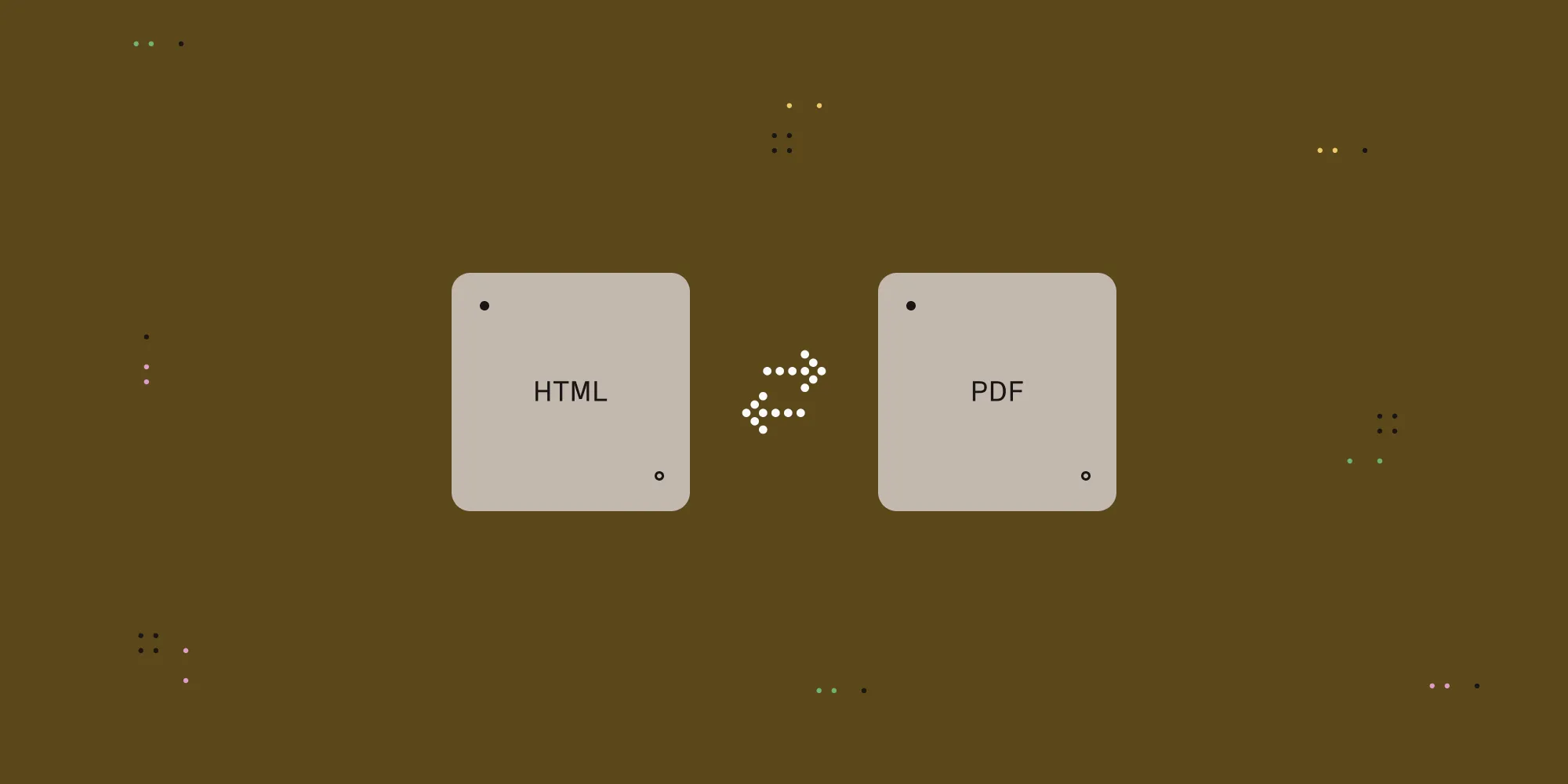Comparing top tools for HTML-to-PDF conversion
Table of contents

In a perfect world, converting HTML to PDF would be a simple, straightforward process to incorporate into your app design. And it can be if you have the right tool.
But not all conversion tools are created equal, and if your app needs the functionality to convert HTML to print-ready PDFs — for example, documents, reports, or invoices — using the wrong conversion tool can not only cause serious frustration for your development team and end users, but also cost your company time and money.
So, the question is: What, exactly, is the best HTML-to-PDF conversion tool?
This article will compare some of the top tools for HTML-to-PDF conversion and guide you in determining which tool is the right one for your business.
Why you need the right HTML-to-PDF conversion tool
First things first. Before jumping into the different conversion tool options, it’s important to understand why you need an HTML-to-PDF conversion tool to begin with.
HTML and PDF formats have major differences. For example, HTML uses a flow-based layout, which means the different elements can adjust based on different factors, like screen size and resolution. Meanwhile, PDFs have a fixed layout that displays the elements consistently across devices and platforms. Browsers render HTML in real time, while PDFs are prerendered, which is why you can view them offline.
The right tool converts the HTML format into the PDF format and maintains consistency through the conversion. But not all tools are created equal, and the wrong tool can cause a host of issues for your business, your engineers, and your end users.
- Lost time and money — Without the right conversion tool, your team could lose hours manually fixing conversion-related errors, like formatting issues. And the more time your team spends dealing with these issues, the higher your labor costs, which means that not only do your employees lose time, but your business loses budget.
- Lost patience — Not only will the wrong HTML-to-PDF conversion tool cost your team time and your business money, but having to spend their time and energy fixing mistakes — mistakes that could have been avoided with the right tool — can also make your team lose patience and lead to morale issues.
- Security and compliance issues — If your application deals with sensitive data, like customer credit cards or healthcare information, using an HTML-to-PDF conversion tool that doesn’t prioritize security and/or adhere to relevant privacy regulations (like HIPAA) could put you at risk of a breach.
On the flip side, choosing the right tool can offer a host of benefits, like increased efficiency, enhanced security and compliance, and major savings — time, cost, energy, and frustration — for your team and business.
Top HTML-to-PDF conversion tools for 2025
Now that you understand the importance of the right HTML-to-PDF conversion tool, this section will cover some of the top tools on the market.
Nutrient
Nutrient offers the tools developers need to seamlessly embed effective document technology into their applications, including HTML-to-PDF conversion.
With Nutrient, developers have the tools they need to ensure their applications feature effective, secure, and scalable document viewing, generation, and HTML-to-PDF conversion — in addition to other processing capabilities.
Whether your team is working in web frameworks like Javascript, Angular, Vue, or Typescript; .NET frameworks like Delphi or WinForms; or cross-platform tech like React Native, Flutter, or Electron, Nutrient.io has you covered with SDKs that allow you to integrate HTML-to-PDF conversion functionality into your apps without having to code from scratch.
What sets Nutrient apart? It stands out for a variety of reasons:
- Correct rendering and formatting with HTML-to-PDF conversion, ensuring the final PDF looks exactly like the original HTML content
- Native SDKs for multiple frameworks
- Fast conversions
- Enterprise-grade security with SOC 2 Type 2 compliance
- GDPR and HIPAA compliance
- PDF previews
- Reliability across different development environments, which is ideal for companies with variable tech stacks
- Scalable without losing speed, accuracy, or quality
- Advanced PDF features and customization options
Bottom line? If you’re looking for a tool that offers all of the document-related functionality you could need, including the ability to convert HTML to PDFs, Nutrient is a fantastic choice.
DocRaptor
DocRaptor(opens in a new tab) offers solid HTML-to-PDF conversion capabilities thanks to its unique HTML-to-PDF API. While it may not match Nutrient’s comprehensive language and framework support, it’s still a reliable choice.
Some of DocRaptor’s features and benefits include:
- 99.99% uptime guarantee
- SOC 2 security compliance
- HIPAA compliance
- Advanced PDF features, like page flexibility, advanced floats, and integrated headers and footers
- PDF-specific JavaScript
PDFShift
With the tagline “from HTML to pixel-perfect in seconds,” PDFShift(opens in a new tab) positions itself as a speedy, developer-friendly option for HTML-to-PDF conversion.
PDFShift claims a variety of benefits and features, including:
- HTML-to-PDF conversion in under two seconds
- Easy-to-generate PDF previews
- Integration with third-party libraries like Tailwind, Bootstrap, Bulma, and Skeleton
- Secure content storing options via S3 Bucket
HTML2PDF Rocket
Looking for a free (or low-cost) option? HTML2PDF Rocket(opens in a new tab) is an easy-to-use web service for converting HTML to PDFs. While it lacks the more robust functionality of Nutrient and some of our other picks, it’s a simple, straightforward option to use, especially for smaller companies looking for a cost-effective HTML-to-PDF conversion tool.
Things to note about HTML2PDF:
- Free for low volume processing
- Affordable pricing for higher volume conversion needs
- Cut-and-paste example code
- Average conversion time of 0.65 seconds
- Best for simple conversion needs, as it provides limited options for more complex asks, like working with multiple programming languages or scaling the application
How to choose the right tool for your business
While this post outlines a few HTML-to-PDF conversion tools to get your wheels turning, the platforms mentioned here don’t even scratch the surface of available HTML-to-PDF conversion tools on the market. With so many options available, the question is, how do you choose the right option for your team and for your business?
Here are some tips for evaluating HTML-to-PDF conversion tools and ultimately choosing the best tool for your developers, your end users, and your company.
Make a list of needs and compare those needs to the tool’s features
When it comes to choosing the “right” HTML-to-PDF conversion tool — or any tool, for that matter — there’s no one-size-fits-all solution. The right tool for you might not be the best choice for another company.
The first step to figuring out the right tool for you is defining what, exactly, you need that tool to do. Before you start the search for an HTML-to-PDF converter, make a list of all the features you’re looking for.
For example, take a look at your tech stack. In what framework does your team primarily work? Do you need support for multiple languages, like C# and Java? Understanding your current tech stack can help you choose a tool that will fit easily into that tech stack and help you avoid potential integration issues in the future.
Or, as another example, think about what you need from security and compliance. Do you handle medical or health-related data? Then you’ll need a tool that’s HIPAA-compliant. Want to mitigate risk and protect your data? Look for a tool that prioritizes security and offers SOC 2 compliance.
The point is, before you start looking at HTML-to-PDF conversion tools, it’s important to clearly define what you need from that tool and then choose accordingly.
Consider volume needs
The best tool for your organization is going to vary based on how many HTML-to-PDF conversions your application needs to perform. If you’re only converting a handful of documents on a regular basis, then you’ll probably be able to get by with a simple tool. But if you’re processing thousands of conversions (or are planning to in the future), you’ll want to look for a more robust solution that’s designed for high-volume performance and scalability.
Look at the big picture on pricing
Obviously, cost is an important factor when making business decisions, including with whatever HTML-to-PDF conversion tool you choose. But while it might be tempting to go with the most affordable option available, it’s important to remember that the price of a tool doesn’t always reflect its true cost, and going with the cheapest option might actually cost you more money down the road.
Why? Because often, the cheapest tool is also the least effective. And while you might be paying less per month or year than you would with other, more effective options, you’ll be losing money in other areas, e.g. developers needing to spend more time on troubleshooting, navigating the platform, or manually fixing errors (which can lead to increased labor costs), or on losing customers after a data breach.
The point is, when you’re evaluating tools, make sure you’re looking at the big picture on pricing and choosing an HTML-to-PDF conversion tool that’s effective and secure and works with your budget.
Try before you buy
Sometimes, the only way to know if an HTML-to-PDF converter is going to be right for your business is to actually try it out and, luckily, many conversion tools offer free trials or demo periods allowing you to “try before you buy.”
If there’s a tool you’re interested in, sign up for the free trial and get to work testing it out. For example, try converting complex documents to check for speed and accuracy, have your developers work with the code and give their insights on the integration process, or reach out to customer service with an issue and see how they respond.
Rolling up your sleeves and actually using the tool is the best way to know how it’s going to work with your business and team. If the tool you’re considering offers a free trial, taking advantage of it is a no-brainer.
Conclusion
At Nutrient, we offer a couple of options for converting HTML to PDF:
- HTML-to-PDF API — A REST API and hosted solution that provides 200 free credits per month and offers additional packages for a per-document fee. This option allows you to integrate HTML-to-PDF conversion into your applications without the need for self-hosting or a server setup.
- PDF Generation SDK — This allows you to generate a PDF from scratch, leveraging HTML and CSS technologies for highly flexible designs and context-customized PDFs for your users.
If you want to experience firsthand how Nutrient can help you accelerate your digital transformation with powerful document technology — including HTML-to-PDF conversion functionality — contact us, or get started for free today.
FAQ
Why does my business need an HTML-to-PDF conversion tool?
If your company generates invoices, reports, contracts, or compliance documents, you need a tool that ensures accurate, professional-looking PDFs every time. A good converter saves time, prevents formatting errors, and ensures documents are secure and compliant.
How do I know which HTML-to-PDF converter is right for my business?
The best tool depends on your business needs. Look for: - Consistent formatting — Ensures documents look professional. - Security and compliance — Protects customer data and meets legal requirements. - Scalability — Handles high-volume conversions without slowing down.- Integration — Works with your existing CRM, ERP, or workflow automation tools.
Can an HTML-to-PDF tool integrate with our current software?
Yes! Many solutions offer easy integrations with popular business platforms, including accounting, CRM, and ERP systems. Nutrient, for example, provides developer-friendly SDKs and APIs to fit seamlessly into your workflows.
Is an online HTML-to-PDF converter secure for sensitive business documents?
Not all online converters prioritize security and compliance. If your business handles confidential customer information, legal contracts, or financial reports, choose a tool with SOC 2, GDPR, or HIPAA compliance to ensure data protection.
Will my converted PDFs always match the original HTML layout?
That depends on the tool you choose. Some conversion tools struggle with complex formatting, tables, and images, leading to misaligned or incomplete PDFs. A high-quality tool like Nutrient ensures pixel-perfect accuracy, preserving branding, fonts, and layouts.
Can an HTML-to-PDF solution handle large volumes of documents?
If your company processes hundreds or thousands of PDFs per day, you need a tool built for high-volume, automated conversion. Nutrient is scalable and reliable, making it a great fit for growing businesses.
How much does an HTML-to-PDF conversion tool cost?
Pricing varies based on features, security, and scalability. Free or low-cost tools may work for small, occasional needs, but enterprise-grade solutions offer better security, automation, and support — saving you time and money in the long run.
Can I try an HTML-to-PDF converter before committing?
Yes! Many tools, including Nutrient, offer free trials or demos, so you can test features, performance, and ease of use before making a decision.







